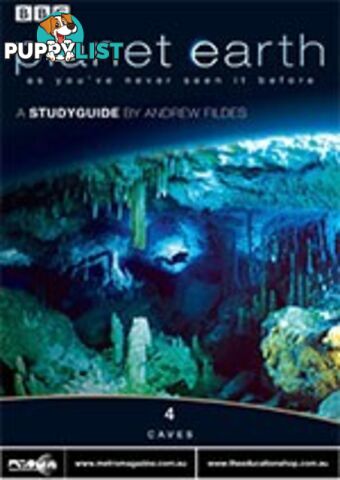This ad is on hold, please check again later.
Planet Earth - Episode 04 (Caves) ( Study Guide)
$7.50

DESCRIPTION
Planet Earth is a BBC production with five episodes in the first series (episodes one through five) and six episodes in the second series (episodes six through eleven). Each episode examines a specific environment, focussing on key species or relationships in each habitat; the challenges they face; the behaviours they exhibit and the adaptations that enable them to survive. Recent advances in photography are used to achieve some spectacular 'first sights' – in particular, stabilised aerial photography gives us remarkable views of migrating animals and the techniques used by their predators to hunt them. As the series examines pristine environments where possible, they are often extreme. These are the parts of the world where few humans have chosen to live as the climate and landscape is too challenging, too difficult and dangerous. The plants and animals that do survive here have made some spectacular adaptations in forms and behaviour to live in these far reaches of the planet. The series is suitable for middle secondary students studying Science and SOSE, and for senior secondary students of Biology, Environmental Science and Geography. The Caves episode begins dramatically as a man hurls himself into the void of the Cave of Swallows in Mexico. We soon realize that he is a base jumper and we watch as he and his friends parachute down into the largest cave shaft in the world, 400 metres deep. Caves are one of the least explored places on Earth and we rarely venture deep into them. If we do, we find that many animals and organisms have made their home in the dark. In New Zealand, tiny glow-worms hang from the roof of caves creating a galaxy of tiny, blue 'stars' in the eternal night. The reality is less romantic as they are luring cave insects into the sticky strands of mucus that they dangle as traps. Most large caves like those seen here are formed in the limestone that covers ten percent of the land, limestone that was once part of the seabed. Acidic water literally dissolves the rock to produce sometimes awe-inspiring chambers such as Deer Cave in Borneo, home to three million small bats. All the energy in the cave is brought in by the bats – the enormous mound of droppings beneath their roost which is literally seething with life. Swarms of cockroaches feed on the guano and anything else that falls from the roof, dead or alive. The bats leaving the cave at twilight form an immense rolling swarm which is promptly attacked by falcons and bat-hawks. The walls of the cave are also home to swiflets, small birds that use a similar echolocation technique to the bats to find their nests in the dark. These are the bird's nests that are harvested for gourmet soup by local villagers, hanging on to ropes and makeshift ladders high above the cave floor to collect the precious little cups. In the Yucatan region of Mexico, there are no surface rivers or lakes, only a massive 500km network of flooded caves below the surface. Any rainfall sinks into the limestone rock and becomes part of these subterranean rivers. Just as with the base jumpers, this is an irresistible lure to adventurers, cave divers who explore and map the system at enormous risk to themselves in one of the most dangerous sports around. Half flooded sea caves in New Zealand provide haven for huge shoals of fish every night while nocturnal fish emerge from the cave each night in their turn. Many cave dwellers have special abilities to make life in the dark possible, just as the bats and swiftlets use echolocation (sonar). A cave snake catches bats as they fly past by sensing their thermal image and striking. Some animals choose to stay deep in the dark for life and have changed irreversibly as a result. Troglobytes like cave angel fish in Thailand who hang on to walls, feeding on bacteria in waterfalls; blind, white salamanders which must detect even the slightest movement to catch food; blind crabs that pick through the debris to find any organic material to eat. There are the fish that live in the acidic waters of the Villa Luz sulphur cave and the colonies of bacteria on the walls, extremophiles, that exude sulphuric acid. Life adapts to any environment it seems. Finally we enter the most beautiful cave system ever discovered, so fragile that even scientists have to seek permission to enter. Lechuguilla in the USA has walls covered with exquisite and delicate structures of gypsum crystals up to six metres long. As film crews are normally excluded to protect the formations and the environment of the cave, this is one of the first detailed views we have had of this amazing cave and possibly the last. SKU: SG410 Visit our website to view thousands more products like this and order online at:ADDITIONAL INFORMATION
- Price
- $7.50
- Condition
- New
- Delivers To
- Australia Wide








